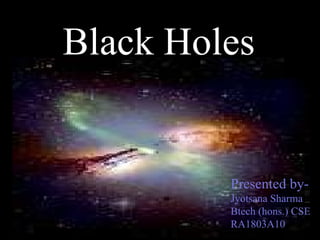
Black holes (2)
- 1. Black Holes Presented by- Jyotsana Sharma Btech (hons.) CSE RA1803A10
- 3. History-- The idea of preventing light from escaping as described by general theory of relativity was given by John Michelle. Even the British astronomer Pierre -Simon Laplace came with the same conclusion.
- 4. The intense gravitational field left when a giant star collapses. It is called a black hole because not even light can escape. Objects too heavy to be neutron stars collapse to black holes. Formation-
- 5. Formation Continued… As the mass increases, so does the gravitational pull. If the gravitational pull is such that even light can escape , then a black hole is formed.
- 6. Gravity deforms space time Diagrammatical representation
- 7. Gravity bends the path of light
- 8. Event horizon The point at which no light can escape.
- 10. Falling into a black hole Falling into a black hole gravitational tidal forces pull spacetime in such a way that time becomes infinitely long (as viewed by distant observer). The falling observer sees ordinary free fall in a finite time.
- 14. 1-Accertion disks and gas jets. 2-Strong Radiation emissions 3-Gravitational lensing Techniques for finding black holes
- 15. Types of Black Holes-- 1-Supermassive Black holes. 2-Stellar- mass black holes. 3-Intermediate mass black holes.
- 16. Advantages and Disadvantages-- They can be significant in this way: 1-Individual modes may dominate the time evolution of some perturbation, and a whole set of them could be used to completely describe this time evolution. The disadvantages are that – 1-when a black hole evaporates information is really gone. 2-Due to this there is trouble in energy conservation. 3-Invariance in time predictability.
- 17. References--- 1-www.google.com. 2-www.wikipedia.com. 3-Anatony on Black holes.
- 18. THANK YOU ANY QUESTIONS???? ???